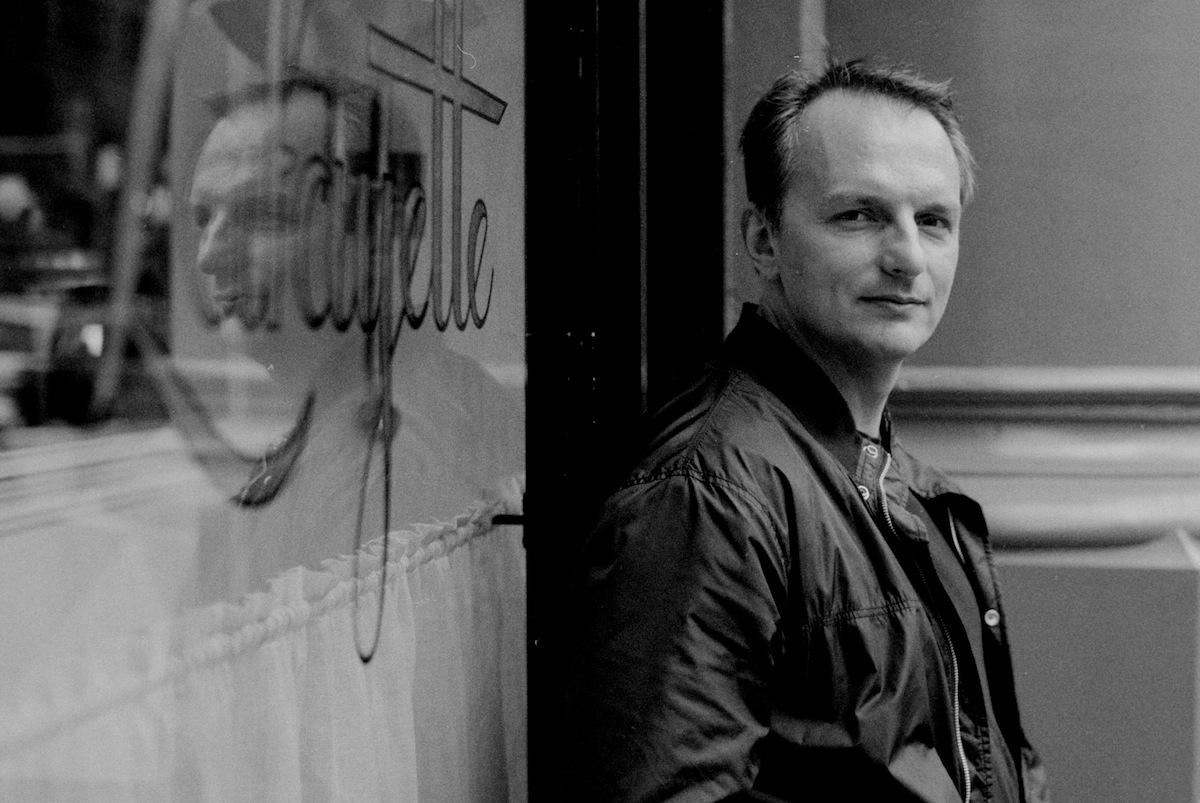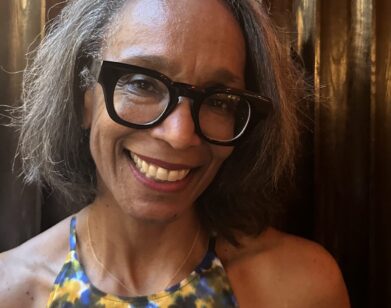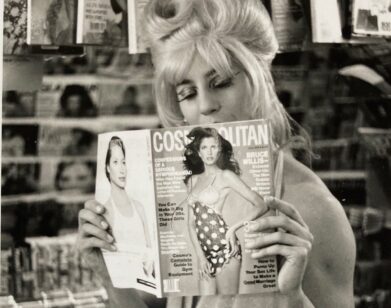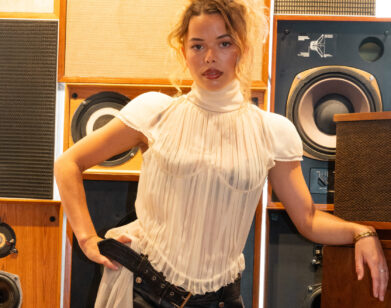For Andrew Carmellini, Simple is Beautiful

ABOVE: ANDREW CARMELLINI OUTSIDE OF LAFAYETTE. PHOTO BY FRANK SUN
Andrew Carmellini talks about food in a breathless stream of consciousness. On oysters, he mentions context–historically, they are a “centerpiece” of American dining–and attributes: East Coast are meaty and briny, West Coast are creamy-meaty. Most places do not shuck them correctly. “The meat’s cut, there’s shell inside. They’re just not properly done,” he bemoans. To him, that’s a travesty. It’s this precision that has driven his two New York restaurants, the Italian tavern Locanda Verde and the New World American spot The Dutch, to incredible success. With his new restaurant Lafayette opening this week, Carmellini adds a French bistro to his portfolio, reacquainting downtown Manhattan with French country cuisine.
In creating the ultimate French eatery, Carmellini, working with his partner Luke Ostrom and chef de cuisine Damon Wise, left no baguette un-sliced. To relate his vision to husband-and-wife interior designers Roman and Williams, who also designed The Dutch, he showed them hundreds of pictures taken in France, from cheese to crockery to shop signs. The restaurant’s aesthetic blends them all.
Carmellini is happy to have an outlet for his love of all things French. A precocious child chef, he studied at the Culinary Institute of America before working in Italy. He returned to New York, but soon went back to Europe, this time with France in mind. “It’s such a beautiful country. It has high-end places, but it was the country style cooking that I liked,” he says. Back in New York again, he was hired by the French chef Daniel Boulud as Café Boulud’s chef de cuisine. In spite of his prestigious position, Carmellini’s heart remained in the French locale. During a visit last summer, he cooked simple meals with ingredients from local markets. “Delicious,” he says. That’s the essence he’s trying to capture with Lafayette.
Located in what had been Chinatown Brasserie, the first foodstuffs you see walking into Lafayette are croissants stacked on brass tiered trays. The bakery, which takes up the front space, also sells freshly baked bread, macarons (there’s a cake flavor), and petite madeleines, among other treats. For the kitchen, a custom rotisserie cooks meat throughout the day.
When we spoke with Carmellini, there was less than a week until the opening and preparations were getting intense. He’s come a long way from making up cookie recipes in his parents’ kitchen.
RACHEL SMALL: When did you start cooking?
ANDREW CARMELLINI: I’ve always loved eating and cooking… I just got into it. I was really young and a little bit hyperactive, too. It calmed me down a lot. I was really into baking more than anything else. I used to make cakes and jelly rolls. I was an inventor of cookies when I was a kid.
SMALL: [laughs] That’s a very useful skill to have when you’re just a child. I feel like all kids want limitless cookies, and you were able to supply those for yourself.
CARMELLINI: There was a lot of experimentation going on. I realized I actually didn’t like paying attention to the measurements, and that’s when I started in the kitchen. After high school, I decided to go to cooking school. In 1989, there was basically Gourmet magazine, and that was about it. And Julia Child. So when I told people I was going to go be a chef, it was as if I told my friends I was going to go be a monk. It’s very different than the way the profession is viewed now.
SMALL: Having worked in both Italy and France, how would you say the approach to food is different?
CARMELLINI: I don’t really see a difference at all. Food in both places is an inherent part of everyday life in a natural way. It’s not forced. I would say it’s different from America as a whole. It’s changed so much in the last 25 years as far as how we enjoy food—that’s for sure. It’s a shorter history than it is in Europe.
SMALL: Hopefully we’re catching up. How was working for Daniel Boulud?
CARMELLINI: Daniel’s a great restaurateur. I was with him at an exciting time, because he was opening his second restaurant, Café Boulud, uptown. He wanted an American chef to run it and he chose me. Then, when I started my own business, I wanted to come back downtown. Also, Locanda Verde, The Dutch, and Lafayette, they’re all on corners. I want my restaurants to I feel like I could eat in them every day. It’s not so much about big entertainment value.
SMALL: When you opened Locanda Verde, your first restaurant, what were you expecting?
CARMELLINI: I was already pretty familiar with the ins and outs of what the actual experience was. To do this, you better love it. If not, there are better things to do. Some days it’s really tremendous successes and then it’s followed by epic failure. You have to be able to deal with that on a daily basis. I was joking the other day, there’s a dish on every opening menu that we think is going to be great, and once we actually open and start to serve it, we take it off the menu because it doesn’t work out. Often, the one I think everyone’s going to love turns out to be the thing that no one writes about and no one loves. Sometimes, it’s because we can’t execute it for the amount of people that show up.
SMALL: I feel like people forget how much work the end product takes.
CARMELLINI: Yes. We’ve experimented with French mashed potatoes over the years. To prepare it, you need great technique and great ingredients. Most people don’t appreciate it because it’s just mashed potatoes to them. They’re either good or bad, you know what I mean?
SMALL: [laughs] Definitely. Speaking of things that can be very bad or very good, can you talk a little bit about the oysters at The Dutch? I’m personally a huge fan.
CARMELLINI: I wanted to open up a neighborhood American restaurant to celebrate American food. And I just love oysters. That’s why I have the one room in the corner of The Dutch that’s the oyster room. Opening up oysters, too, it’s a very simple thing, but there are not a lot of restaurants that open oysters properly. We were big sticklers when we opened just in training and making sure the oysters get opened properly. It’s amazing how many young chefs that come out of cooking schools who don’t know how to open up oysters.
SMALL: [laughs] That seems like cooking 101, how to shuck an oyster.
CARMELLINI: Shuck an oyster, truss a chicken, make a vinaigrette, it’s basic, basic, basic cooking.
SMALL: Where do you scout out good ingredients?
CARMELLINI: In New York, we know the best local producers. Actually, I can’t wait until the season starts up because right now vegetables are kind of sad. They are just missing that vibrancy and that flavor.
SMALL: It must be difficult to make plant-based dishes without the simple ingredients being right-on.
CARMELLINI: Yeah. I went to a house over the summer in the south of France. We didn’t go to all the restaurants. We just cooked at the house every day and went to the markets, and had big dinners. We grilled wild fish in olive oil and simple vegetables from the market. It was so freaking amazing, and it was great because the ingredients were great. I want to have that same feeling here at Lafayette, I want it to be evocative of that. I want Lafayette to be the spirit of French cooking, and of the whole country.
SMALL: I heard Lafayette aims to “reinvent” French food. Is that the way you are approaching it?
CARMELLINI: I don’t think it’s reinventing. I’ve always wanted an Italian restaurant, an American restaurant, and a French restaurant. I wanted to have a French restaurant because I lived and worked in France for a long time, and I love the country-style cooking in France. It’s not so much about reinventing as it is doing simple things really well, and taking a fresh look at French cooking because there hasn’t been a lot of interesting French cooking. It’s lost its luster on the international stage. But this is not a high-end restaurant; it’s an everyday restaurant where we spend a lot of time testing and testing and testing.
SMALL: What’s the story behind the “nous sommes la cuisine“ posters on the windows, that were up while the restaurant was under construction?
CARMELLINI: Oh, that. That was a complete rip-off from the student protests that were in Paris in the late ’60s. There’s a very famous one called “nous sommes le pouvoir.” Which basically means “we are the power.” It was in the same silhouette style, except the original ’60s posters showed workers. I thought it would be cool to change the silhouette to chefs, holding pots and spoons, and change the slogan to “we are the kitchen,” so “nous sommes la cuisine.” It was actually a decoration from a party we threw, and we decided to put them up. Being in the kitchen is a physical job, and personally I found a lot of inspiration in the image.
SMALL: Is there any guiding principle that you’ve learned from your past restaurants and your past experiences as a chef that you want to take to Lafayette?
CARMELLINI: It’s what I try to do with the other restaurants. We’re just going to treat everyone well and make tasty, delicious things. It’s not more complicated than that.
SMALL: What is the secret of making everything so delicious?
CARMELLINI: Delicious for me can be simple steamed fish with really good olive oil and a really simple vinaigrette, as well as something full-flavored and really meat-centric with a lot of garlic and chili and herb. It depends on the spirit of the dish. We will have Moroccan lamb on the menu at Lafayette when it opens. You can’t deny the French-Moroccan connection, and I wanted to celebrate that in a culinary way. That dish has preserved lemon and tagine spices and chilies, and it’s a pretty full-flavored dish. If you eat that dish next to, say the beautiful black sea bass that’s steamed in the steamer with artichoke barigoule and white wine and lots of herbs, and some bread crumbs on top—it’s so delicious I could eat that dish every day—if you eat them next to each other, one is super spicy flavorful, garlic, chilies, and the next one is just really natural and pleasant. [laughs] But both things are delicious, I think.
LAFAYETTE IS AT 380 LAFAYETTE STREET IN NEW YORK. FOR RESERVATIONS, VISIT WWW.LAFAYETTENY.COM.






